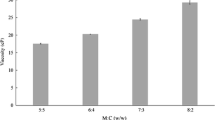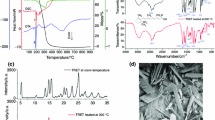Abstract
Eutectic mixtures formed between active pharmaceutical ingredients and/or excipients provide vast scope for pharmaceutical applications. This study aimed at the exploration of the crystallization abilities of two eutectic mixtures (EM) i.e., lidocaine-tetracaine and lidocaine-camphor (1:1 w/w). Thermogravimetric analysis (TGA) for degradation behavior whereas modulated temperature differential scanning calorimetry (MTDSC) set in first heating, cooling, and second heating cycles, was used to qualitatively analyze the complex exothermic and endothermic thermal transitions. Raman microspectroscopy characterized vibrational information specific to chemical bonds. Prepared EMs were left at room temperature for 24 h to visually examine their crystallization potentials. The degradation of lidocaine, tetracaine, camphor, lidocaine-tetracaine EM, and lidocaine-camphor EM began at 196.56, 163.82, 76.86, 146.01, and 42.72°C, respectively, which indicated that eutectic mixtures are less thermostable compared to their individual components. The MTDSC showed crystallization peaks for lidocaine, tetracaine, and camphor at 31.86, 29.36, and 174.02°C, respectively (n = 3). When studying the eutectic mixture, no crystallization peak was observed in the lidocaine-tetracaine EM, but a lidocaine-camphor EM crystallization peak was present at 18.81°C. Crystallization occurred in lidocaine-camphor EM after being kept at room temperature for 24 h, but not in lidocaine-tetracaine EM. Certain peak shifts were observed in Raman spectra which indicated possible interactions of eutectic mixture components, when a eutectic mixture was formed. We found that if the components forming a eutectic mixture have crystallization peaks close to each other and have sufficient hydrogen-bonding capability, then their eutectic mixture is least likely to crystallize out (as seen in lidocaine-tetracaine EM) or vice versa (lidocaine-camphor EM).








Similar content being viewed by others
References
Avula SG, Alexander K, Riga A. Predicting eutectic behavior of drugs and excipients by unique calculations. J Therm Anal Calorim. 2010;99:655–8.
Stott PW, Williams AC, Barry BW. Transdermal delivery from eutectic systems: enhanced permeation of a model drug, ibuprofen. J Control Release. 1998;50:297–308.
Bi M, Sung-Joo H, Kenneth RM. Mechanism of eutectic formation upon compaction and its effects on tablet properties. Thermochim Acta. 2003;404:213–26.
Ehrenstrom-Reiz GME, Reiz SLA. EMLA—a eutectic mixture of local anaesthetics for topical anaesthesia. Acta Anaesthesiol Scand. 1982;26:596–8.
Keiji S, Noboru O. Studies on absorption of eutectic mixture I. A comparison of the behavior of eutectic mixture of sulfathiazole and that of ordinary sulfathiazole in man. Chem Pharm Bull. 1961;9:866–72.
Goldberg AH, Gibaldi M, Kanig JL. Increasing dissolution rates and gastrointestinal absorption of drugs via solid solutions and eutectic mixtures II: experimental evaluation of a eutectic mixture: urea-acetaminophen system. J Pharm Sci. 1966;55:482–7.
Nazzal S, Smalyukh II, Lavrentovich OD, Khan MA. Preparation and in vitro characterization of a eutectic-based semisolid self-nanoemulsified drug delivery system (SNEDDS) of ubiquinone: mechanism and progress of emulsion formation. Int J Pharm. 2002;235:247–65.
Gala U, Pham H, Chauhan H. Pharmaceutical applications of eutectic mixtures. J Dev Drug. 2013;2:1–2.
Tainmont J. Dr Bonain, an ENT surgeon with an ocean background. B-ENT. 2007;3:217–30.
Jyvakorpi M. A comparison of topical Emla cream with Bonain’s solution for anesthesia of the tympanic membrane during tympanocentesis. Eur Arch Otorhinolaryngol. 1996;253:234–6.
Brodin A, Nyqvist-Mayer A, Wadsten T, Forslund B, Broberg F. Phase diagram and aqueous solubility of the lidocaine-prilocaine binary system. J Pharm Sci. 1984;73:481–4.
Berndt B, Hans E. Local anesthetic mixture for topical application, and process for its preparation, as well as method for obtaining local anesthesia. US 4562060 (1985).
Nyqvist-Mayer A, Brodin F, Frank G. Phase distribution studies on an oil–water emulsion based on a eutectic mixture of lidocaine and prilocaine as the dispersed phase. J Pharm Sci. 1985;74:1192–5.
Luotonen J, Laitakari K, Karjalainen H, Jokinen K. EMLA in local anaesthesia of the tympanic membrane. Acta Otolaryngol. 1992;492:63–7.
Hahn IH, Hoffman RS, Nelson LS. EMLA-induced methemoglobinemia and systemic topical anesthetic toxicity. J Emerg Med. 2004;26:85–8.
Vasters FG, Eberhart LH, Koch T, Kranke P, Wulf H, Morin AM. Risk factors for prilocaine-induced methaemoglobinaemia following peripheral regional anaesthesia. Eur J Anaesthesiol. 2006;23:760–5.
Boran P, Tokuc G, Yegin Z. Methemoglobinemia due to application of prilocaine during circumcision and the effect of ascorbic acid. J Pediatr Urol. 2008;4:475–6.
Jun HW, Kang L. Enhanced transdermal anesthesia of local anesthetic agents. WO2000069471 A1 (2001).
The PubChem Structure Search Database. http://pubchem.ncbi.nlm.nih.gov/search/search.cgi Accessed 13 August 2014.
Kang L, Jun HW, Mani N. Preparation and characterization of two phase melt systems of lidocaine. Int J Pharm. 2001;222:35–44.
Woolfson AD, McCafferty DF, Moss GP. Development and characterisation of a moisture-activated bioadhesive drug delivery system for percutaneous local anaesthesia. Int J Pharm. 1998;169:83–94.
Teng J, Liu S. Re-determination of succinonitrile (SCN)–camphor phase diagram. J Cryst Growth. 2006;290:248–57.
Alster T. A lidocaine 7% and tetracaine 7% peel for induction of local dermal anesthesia for nonablative facial laser resurfacing. J Am Acad Dermatol. 2005;52:44.
Goldberg L. A lidocaine 7% and tetracaine 7% peel for local dermal anesthesia before cryotherapy treatment for actinic keratosis. J Am Acad Dermatol. 2005;52:44.
Fitzpatrick R. A lidocaine 7% and tetracaine 7% peel before pulsed dye laser therapy to treat facial lesions in adults. J Am Acad Dermatol. 2005;52:44.
Corvis Y, Espeau P. Incidence of chirality on the properties of mixtures containing an amide type anesthetic compound. Thermochim Acta. 2012;539:39–43.
Giron D. Applications of thermal analysis in the pharmaceutical industry. J Pharm Biomed Anal. 1986;4:755–70.
Coleman J, Craig DQM. Modulated temperature differential scanning calorimetry: a novel approach to thermal analysis. Int J Pharm. 1996;135:13–29.
Giron D. Contribution of thermal methods and related techniques to the rational development of pharmaceuticals—part 1. Pharm Sci Technol Today. 1998;1:191–9.
Kemp RB. Handbook of thermal analysis and calorimetry: from macromolecules to man. Amsterdam: Elsevier Science; 1999.
Giron D. Thermal analysis, microcalorimetry and combined techniques for study of pharmaceuticals. J Pharm Thermal Anal Calorim. 1999;56:1289–304.
Clavaguera N, Saurinab J, Lheritierc J, Massec J, Chauvetc A, Clavaguera-Morad MT. Eutectic mixtures for pharmaceutical applications: a thermodynamic and kinetic study. Thermochim Acta. 1997;290:173–80.
Clas SD, Dalton CR, Hancock BC. Differential scanning calorimetry: applications in drug development. Pharm Sci Technol Today. 1999;2:311–20.
Ratkje SK, Rytter E. Raman spectra of molten mixtures containing aluminum fluoride. I. Lithium fluoride-trilithium hexafluoroaluminate eutectic mixture. J Phys Chem. 1974;78:1499–502.
Sunol JJ, Berlanga R, Clavaguera-Morad MT, Clavaguera N. Modeling crystallization processes: transformation diagrams. Acta Mater. 2002;50:4783–90.
Ma Y, Gill HS. Coating solid dispersions on microneedles via a molten dip-coating method: development and in vitro evaluation for transdermal delivery of a water-insoluble drug. Pharm Drug Del Pharm Technol. 2014. doi:10.1002/jps.24159.
Shamsudin MS, Asli NA, Abdullah S, Yahya SYS, Rusop M. Effect of synthesis temperature on the growth iron-filled carbon nanotubes as evidenced by structural, micro-Raman, and thermogravimetric analyses. Adv Condens Matter Phys. 2012. doi:10.1155/2012/420619.
Kang L, Jun HW. Formulation and efficacy studies of new topical anesthetic creams. Drug Dev Ind Pharm. 2003;29:505–12.
Giron D, Draghi M, Goldbronn C, Pfeffer S, Piechon P. Study of the polymorphic behavior of some local anesthetic drugs. J Therm Anal. 1997;49:913–27.
Woolfson AD, McCafferty DF. Percutaneous local anaesthesia: drug release characteristics of the amethocaine phase-change system. Int J Pharm. 1993;94:75–80.
Dennis AC, McGarvey JJ, Woolfson AD, McCafferty DF, Moss GP. A Raman spectroscopic investigation of bioadhesive tetracaine local anaesthetic formulations. Int J Pharm. 2004;279:43–50.
Schmidt AC. The role of molecular structure in the crystal polymorphism of local anesthetic drugs: crystal polymorphism of local anesthetic drugs, part X. Pharm Res. 2005;22:2121–33.
Riga AT, Oberoi LM, Alexander KS. Calorimetry as a preformulation tool for studying eutectics relevant in pharmaceuticals. Am Pharm Rev. 2004;7:18–23.
Vepuri SB, Anbazhagan S, Divya D, Padmini D. A review on supramolecular chemistry in drug design and formulation research. Indones J Pharm. 2013;24:131–50.
Kam NWS. Analysis of drug samples using Raman micro-spectroscopy. Physical Sciences & Mathematics. 2001;5. http://legacy.jyi.org/volumes/volume5/issue1/articles/kam.html. Accessed 12 June 2014.
Daferera DJ, Tarantilis PA, Polissiou MG. Characterization of essential oils from Lamiaceae species by Fourier transform Raman spectroscopy. J Agric Food Chem. 2002;50:5503–7.
Conflict of Interest
The authors report no declarations of interest.
Author information
Authors and Affiliations
Corresponding author
Rights and permissions
About this article
Cite this article
Gala, U., Chuong, M.C., Varanasi, R. et al. Characterization and Comparison of Lidocaine-Tetracaine and Lidocaine-Camphor Eutectic Mixtures Based on Their Crystallization and Hydrogen-Bonding Abilities. AAPS PharmSciTech 16, 528–536 (2015). https://doi.org/10.1208/s12249-014-0242-4
Received:
Accepted:
Published:
Issue Date:
DOI: https://doi.org/10.1208/s12249-014-0242-4




